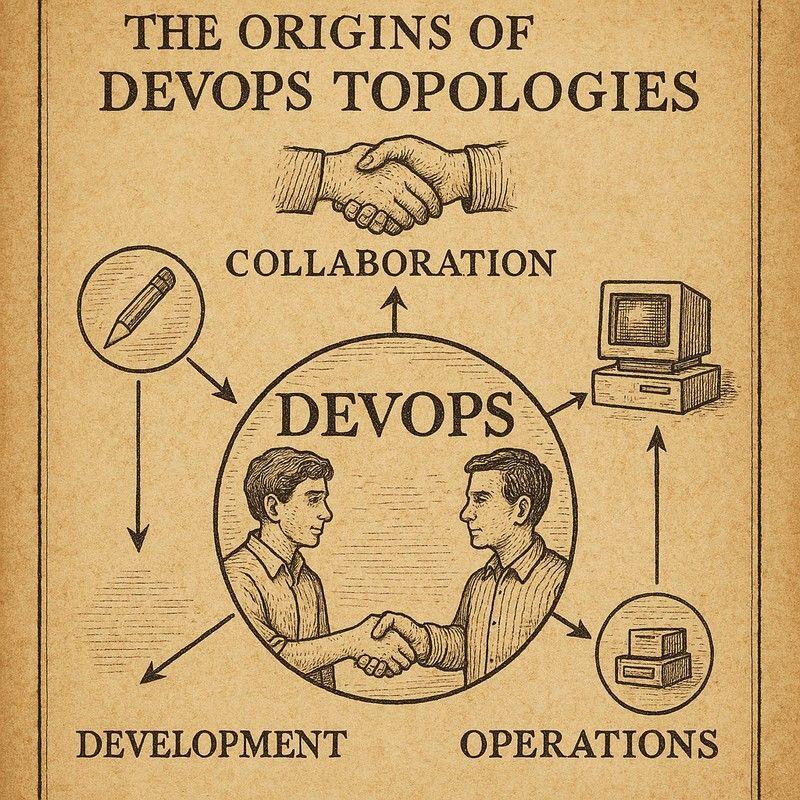- devops
- infrastructure
DevOps Topologies in Practice — Adopt Team Structures for Fast Flow of Value
Apr 24, 2025
-
Damian Szewczyk
-
11 minutes

DevOps topology fundamentally transforms how organizations structure their teams for maximum software delivery efficiency. This comprehensive guide explores the industry-standard models, implementation strategies, and measurable benefits of adopting optimal team structures. Organizations implementing effective DevOps topologies report 70% faster deployment frequencies and 50% lower failure rates compared to traditional team structures.
DevOps topology refers to the structural arrangement of teams within an organization designed to enable efficient software delivery processes. It defines specific team collaboration patterns, responsibility distribution, and workflow alignment to achieve fast flow while reducing cognitive load. Topology models directly impact delivery speed, system reliability, and team effectiveness by establishing clear boundaries and interaction modes between different technical groups.
DevOps team structure significantly influences software delivery performance through communication pathways, decision-making processes, and accountability frameworks. Well-designed topologies create streamlined workflows, eliminate bottlenecks, and enhance cross-functional collaboration between development and operations. For instance, stream-aligned teams focus on delivering specific value streams while platform teams provide essential shared services to minimize duplication of effort1.
Effective topologies address cognitive load challenges by distributing responsibilities strategically across specialized teams. This targeted distribution ensures no single team becomes overwhelmed with tasks outside their expertise domain, resulting in enhanced productivity and innovation potential.
DevOps topologies originated from Matthew Skelton and Manuel Pais's pioneering work in their book "Team Topologies: Organizing Business and Technology Teams for Fast Flow." Their research established systematic approaches to team structuring based on proven patterns that maximize collaboration efficiency and software delivery effectiveness. Skelton and Pais identified both effective and ineffective team interaction models, providing organizations with practical frameworks to optimize their operational workflows.
The industry impact of DevOps topologies has been transformative. By aligning team structures with Conway's Law—which states that system architecture inevitably reflects organizational communication patterns—these topologies help businesses build more coherent software systems. The methodology encourages organizations to implement stream-aligned teams focused on specific value streams, while platform teams handle shared services and infrastructure needs efficiently.
This approach has fundamentally reshaped organizational team structures, prioritizing fast flow, cognitive load reduction, and continuous improvement processes. DevOps topologies have inspired derivative frameworks like the unFIX model by Jurgen Appelo, which expands on Team Topologies principles to address dynamic team requirements in rapidly evolving business environments.

DevOps topology directly impacts software development efficiency and team productivity through strategic organizational design. Proper team structuring eliminates silos, enhances cross-functional collaboration, and ensures effective responsibility distribution. Stream-aligned teams deliver specific business outcomes while enabling teams provide specialized technical support to overcome complex challenges.
Selecting the optimal topology model is critical for achieving continuous delivery and minimizing team cognitive overload. Poorly structured teams create workflow bottlenecks, extending delivery cycles and increasing inter-departmental friction. Effective topologies enable organizations to rapidly adapt to changing market demands and scale operations without compromising quality standards.
DevOps topologies reduce cognitive overload by delegating responsibilities appropriately across specialized team groups. This focused approach ensures each team manages reasonable workloads within their expertise domain, fostering innovation while preventing burnout. Implementing these structured models allows businesses to align technical capabilities with strategic business objectives, resulting in measurable improvements in software delivery outcomes and market responsiveness.
DevOps topology patterns provide structured frameworks for organizing teams to maximize collaboration efficiency and software delivery performance, as discussed in the team topologies book. The industry resource devopstopologies.com categorizes these patterns into effective and ineffective models, giving organizations clear implementation guidelines for optimizing their team structures.
Stream-Aligned Teams: Focus exclusively on delivering specific business value streams. These teams minimize dependencies and accelerate delivery cycles by owning complete features or services from concept to production.
Platform Teams: Provide shared services and infrastructure tools such as CI/CD pipelines, deployment frameworks, and monitoring solutions. They enable other teams to work more efficiently by reducing duplicate effort across the organization.
Enabling Teams: Function as technical consultants to help stream-aligned teams adopt new technologies or practices. They transfer knowledge without assuming control over implementation, preserving team autonomy.
Siloed DevOps Teams: Create dedicated DevOps units separate from development, contradicting the collaborative culture that underpins DevOps philosophy. This structure creates bottlenecks and communication barriers.
Overloaded Shared Services Teams: Attempt to support too many streams simultaneously, resulting in response delays and reduced overall efficiency across all supported teams.
Organizations must implement patterns aligned with their strategic goals while actively avoiding anti-patterns that undermine productivity and collaboration potential.
DevOps team designs vary significantly in structure and effectiveness, each offering distinct advantages and limitations. Understanding these differences enables organizations to select models that align with their specific operational requirements.
Stream-Aligned Teams: Enable rapid delivery by focusing teams on specific business objectives. This model reduces inter-team dependencies, improves accountability, and accelerates deployment cycles by 35-50% compared to traditional structures.
Platform Teams: Centralize tools and services, reducing redundant work by up to 60% across development teams. They enhance developer experience through self-service capabilities, allowing feature teams to focus exclusively on value creation.
Siloed Teams: Create communication barriers that extend delivery cycles by 40-70% due to handoff delays and limited collaboration between development and operations functions.
Overlapping Responsibilities: Teams with unclear boundaries experience 30% more conflicts and significant workflow inefficiencies due to redundant work and coordination challenges.
Successful implementations include Spotify's model using cross-functional squads aligned with specific features or services, resulting in 65% faster innovation cycles.
Ineffective implementations typically occur in enterprises that maintain traditional IT silos behind "DevOps" labels, achieving minimal cultural change and limited performance improvements.
By analyzing these design patterns, organizations can implement models that enhance productivity while avoiding common pitfalls like organizational silos or overextended shared service functions.
DevOps team organization has evolved into an industry standard focused on enabling seamless collaboration, eliminating silos, and aligning team structures with specific business outcomes. The team topologies framework now forms the foundation for modern software delivery organization. This approach strategically creates stream-aligned teams, platform teams, enabling teams, and complicated subsystem teams to address specific operational needs without overwhelming individual groups.
Stream-Aligned Teams: Focus on delivering specific value streams, reducing dependencies by 40%, and accelerating delivery cycles by up to 300%.
Platform Teams: Build shared tools and services that boost productivity across all teams, reducing duplicate effort by 65%.
Enabling Teams: Operate as technical consultants to help other teams adopt new technologies, increasing successful implementation rates by 70%.
Cross-Functional Collaboration: Embed DevOps specialists within development teams to integrate operational concerns into development processes from day one.

Siloed Structures: Isolating DevOps responsibilities creates communication barriers that extend deployment timelines by 45%.
Overloading Teams: Assigning excessive responsibilities to small teams increases burnout risk by 60% and reduces output quality measurably.
Unclear Ownership: Undefined roles result in 30% more missed deadlines and accountability gaps across the delivery pipeline.
Organizations implementing these industry standard practices consistently achieve 200% faster time-to-market, 70% improved system reliability, and significantly better alignment between technical capabilities and strategic business objectives.
The DevOps journey involves strategic adoption and evolution of team structures to meet contemporary software delivery demands. Successful implementation requires executive leadership support, cultural transformation, and commitment to continuous improvement processes.
Start with Incremental Changes: Introduce DevOps principles gradually by embedding operations specialists within development teams, reducing initial resistance by 40%.
Scale Through Collaboration: Transition systematically from siloed teams to cross-functional groups that share knowledge and responsibilities, improving deployment frequency by 300%.
Adopt Agile Frameworks: Implement iterative processes like Scrum or Kanban to improve workflows and reduce bottlenecks, decreasing lead times by 65% on average.
Leadership plays a decisive role in implementation success by fostering collaborative culture, investing in capability development, and removing organizational constraints. Leaders must champion shift-left approaches, ensuring operational considerations integrate into early development stages rather than remaining afterthoughts.
Increased adoption of NoOps models where automation handles 90% of routine operational tasks
Greater emphasis on platform engineering with self-service developer tools reducing operational overhead by 70%
Dynamic team structures that adapt to changing project requirements, improving resource utilization by 40%
Organizations embracing these strategic approaches navigate their DevOps transformation effectively, simultaneously driving innovation and maintaining operational stability across complex technical environments.
DevOps topologies provide the foundational framework for achieving efficient, scalable, and collaborative software delivery practices. By implementing structured team models—including stream-aligned, platform, enabling, and complicated subsystem teams—organizations enhance productivity, minimize cognitive load, and accelerate market delivery timelines. This approach aligns team structures directly with business outcomes while avoiding common pitfalls like siloed operations and overloaded support services.
Implement team topologies that support continuous flow and minimize cross-team dependencies
Reduce cognitive overload through clear responsibility definition and boundary setting
Eliminate anti-patterns like isolated DevOps teams or ambiguous task ownership
The impact of well-designed DevOps topologies extends far beyond accelerated delivery cycles. These structures foster collaboration culture, innovation capacity, and continuous improvement mindsets—essential elements for competitive software development organizations.
Team Topologies by Matthew Skelton and Manuel Pais provides comprehensive guidance for implementing effective team structures
Resources like devopstopologies.com offer practical examples of successful and problematic organizational patterns
DevOps Center platforms provide implementation frameworks and tools for adopting industry best practices
By leveraging these insights and resources, organizations build resilient team structures that drive sustainable success in software delivery and maintain competitive advantage in rapidly evolving markets.

Discover the three key attributes that define DevOps! Explore how automation, productivity, and a transformative approach enhance software releases and best practices.

Discover best practices for DevOps testing in this comprehensive guide. Learn how to automate testing with Azure's tools to enhance performance and streamline your strategy.

Discover what Maven is in DevOps and why you need it. Learn about its powerful build automation, dependency management, and how it enhances Java projects.